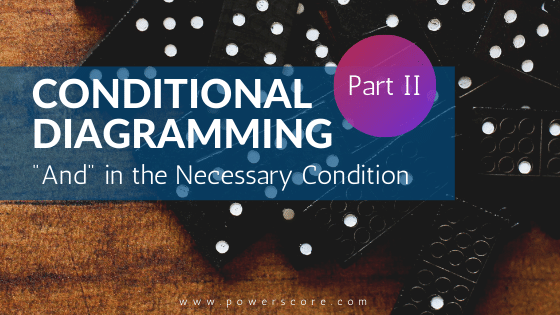In my last post, I discussed conditional statements with “or” in the sufficient condition. Diagrams with multiple necessary conditions can, depending on the circumstances, then be used to create multiple single diagrams. Let’s look at an example.
If the rule reads: “If Operations is offered, then Accounting or Sales is also offered,” then the diagram is solely:
A
O → or
S
Because the necessary condition is just at least one of the two (A or S), you cannot separate this relationship into two separate component statements.
However, if the rule reads: “If Operations is offered, then Accounting and Sales are also offered,” then the single diagram is:
A
O → and
S
But, because O forces both of A and S to occur, the two individual sub-statements also apply:
O → A
and
O → S
Again, how you diagram these statements is sometimes a personal choice, but one that should be made while examining the context of the game and the other rules.


Dave Killoran says
In these cases, while “or” is shared by each statement (and thus perhaps they seem the same), how and where they are shared is different, and that difference explains why they are treated differently. Let’s look at each:
OR on the sufficient side
Let’s take a look at the following statement: A or B –> C.
Here if you have A or B, then you know C. So what happens if you have A and A alone? You’d know the sufficient condition was met and you’d get C. That yields A –> C.
What about for B? What happens if you have B only? You’d know the sufficient condition was met and you’d get C. That yields B –> C.
So, if you have each one individually, you still get C. That’s why we can separate out that condition into two different statements.
OR on the necessary side
Now let’s take a look at the following statement: C –> A or B.
Here’s let’s say we know that C occurs. What does that tell us? Just that A or B (or both) occurred. Can we separate the OR statements out? No, and here’s why. If we have C, do we know that we have A? Meaning, if we have C, do we know that C –> A? No, because it could be B instead of A that happens on the necessary side. The same applies to the relationship of C and B, and so if you tried to do the following:
C –> A
C –> B
That would NOT be correct because when C occurs, only one of the two must happen, and you can’t say it’s always A because it could be B, and you can’t always say it’s B because it could be A. So, you can’t separate out OR on the necessary side into two different, independent statements.
Hopefully that helps. Please let me know. Thanks!